Relative Configuration Space
Previously in series: Mach’s Principle: Anti-Epiphenomenal Physics
Followup to: Classical Configuration Spaces
Warning: The ideas in today’s post are taken seriously by serious physicists, but they are not experimentally proven and are not taught as standard physics.
Today’s post draws on the work of the physicist Julian Barbour, and contains diagrams stolen and/or modified from his book “The End of Time”.
Previously, we saw Mach’s idea (following in the earlier path of Leibniz) that inertia is resistance to relative motion. So that, if the whole universe was rotating, it would drag the inertial frame along with it. From the perspective of General Relativity, the rotating matter would generate gravitational waves.
All right: It’s possible that you can’t tell if the universe is rotating, because the laws of gravitation may be set up to make it look the same either way. But even if this turns out to be the case, it may not yet seem impossible to imagine that things could have been otherwise.
To expose Mach’s Principle directly, we turn to Julian Barbour.
The diagrams that follow are stolen from Julian Barbour’s The End of Time. I’d forgotten what an amazing book this was, or I would have stolen diagrams from it earlier to explain configuration space. Anyone interested in the nature of reality must read this book. Anyone interested in understanding modern quantum mechanics should read this book. “Must” and “should” are defined as in RFC 2119.
Let there be a classical configuration space which describes the 2D positions of A, B, and C. 3 classical 2D particles require a 6-dimensional configuration space.
If your monitor cannot display 6-dimensional space, I’ve set a 2D projection of a 3D cube to appear instead. If you see what looks like a window into an incomprehensible void, try using Firefox instead of Internet Explorer.
The thing about this 6-dimensional cube, is that it contains too much information. By looking at an exact point in this cube—supposedly corresponding to an exact state of reality—we can read off information that A, B, and C will never be able to observe.
The point (0, 1, 3, 4, 2, 5) corresponds to A at (0, 1), B at (3, 4), and C at (2, 5). Now consider the point (1, 1, 4, 4, 3, 5); which corresponds to moving A, B, and C one unit to the right, in unison.
Can A, B, and C ever detect any experimental difference? Supposing that A, B, and C can only see each other, as opposed to seeing “absolute space” in the background?
After we shift the universe to the right (shift the origin to the left), A looks around… and sees B and C at the same distance from itself as before. B and C can’t detect any difference in the universe either.
Yet we have described (0, 1, 3, 4, 2, 5) and (1, 1, 4, 4, 3, 5) as two different points in the configuration space. Even though, to A, B, and C, the associated states of reality seem indistinguishable. We have postulated an epiphenomenal difference: This suggests that our physics is not over the true elements of reality. (Remember, this has been, historically, a highly productive line of reasoning! It is not just logic-chopping.)
Indeed, our classical configuration space has many epiphenomenal differences. We can rotate the three particles in unison, and end up with a different point in the configuration space; while A, B, and C again see themselves at the same distances from each other. The “rotation” that took place, was a matter of us looking at them from a different angle, from outside their universe. Which is to say the “rotation” was a choice of viewpoint for us, not an experimentally detectable fact within the ABC universe.
How can we rid the physics of mind projections and epiphenomena?
A and B and C cannot observe their absolute positions in space against a fixed background. Treating these absolute positions as elements of reality may be part of our problem.
Why not use that as the dimensions of a configuration space?
At right is depicted a relative configuration space whose three dimensions are the distances AB, BC, and CA. It really is 3-dimensional, now!
If you’re wondering why the configuration space looks pyramidal, it’s because any point with e.g. AB + BC < CA is “outside the configuration space”. It does not represent a realizable triangle, because one side is longer than the sum of the other two. Likewise AB + CA < BC and BC + CA < AB.
Every different point in this configuration space, corresponds to an experimentally different state of reality that A, B, and C can observe.
(Oh, and we’re assuming that A, B, and C can tell each other apart—perhaps they are different colors.)
The edges of each slice of the configuration space, are the configurations with A, B, and C on the same line. E.g., if AB + BC = CA, then B lies on a point between A and C.
The corners of each slice are the configurations in which two points coincide; e.g., AB=0, BC=CA.
The point in the center of the slice corresponds to an equilateral triangle.
The dashed lines, which are axes of bilateral symmetry of the configuration space, contain points that correspond to isosceles triangles.
The curved lines are right-angled triangles.
Points “inside” the curved lines are acute triangles; points “outside” the curved lines are obtuse triangles.
What about three points coinciding?
There is no triangle at this scale where all three points coincide.
Remember, this is just one slice of the configuration space. Every point in the whole configuration space corresponds to what ABC experience as a different state of affairs.
The configuration where A, B, and C are all in the same place is unique in their experience. So it is only found in one slice of the configuration space: The slice that is a single point, at the tip of the infinite pyramid: The degenerate slice where the center and the corners are the same point: The slice that is the single point in configuration space: AB=BC=CA=0.
Julian Barbour calls this point Alpha.
But I’m getting ahead of myself, here—that sort of thing is the topic of tomorrow’s post.
To see the power of a relative configuration space, observe how it makes it impossible to imagine certain epiphenomenal differences:
Put your Newtonian goggles back on: imagine A, B, and C as little billiard balls bouncing around in plain old space (not configuration space) and time. Perhaps A, B, and C attract each other via a kind of gravity, and so orbit around one another. If you were looking at the evolution of A, B, and C in plain old space and time, then a strobe-lit photograph of their motion might look like this:
In this time-series photograph, we’ve seen points A, B, and C forming a triangle. Not only do the points of the triangle orbit around each other, but they also seem to be heading down and to the right. It seems like you can imagine the triangle heading off up and to the right, or up and to the left, or perhaps spinning around much faster. Even though A, B, and C, who can only see their distance to each other, would never notice the difference.
Now we could also map that whole trajectory over time, onto the relative configuration space. If AB+BC+CA happens to be a constant throughout the evolution, then we could conveniently map the trajectory onto one slice of configuration space:
(This doesn’t actually represent the triangle-series shown above it, but imagine that it does.)
If this is what you believe to be the reality—this trajectory in the relative configuration space—then, if I ask you to imagine, “Suppose that the triangle is heading up and to the left, instead of down and to the right”, I have just uttered physical nonsense. Mapping that alternative trajectory in Newtonian space, onto the relative configuration space, would produce just the same curve. And if the laws of physics are over the relative configuration space, then this curve is all there is.
Imagine physics over trajectories in a relative configuration space like this one, but with many more particles, and perhaps 3 space dimensions. Sentient beings evolve in this universe, on some equivalent of a planet. They hunt across fields that do not seem to shift underfoot. They have a strong illusion of moving through an absolute space, against an absolute background; the relativity of motion is hidden from them.
But if the fundamental laws of their universe were over relative configurations, then it would not just be a contingent fact about their universe, that if all the particles were speeding or accelerating or rotating in unison, all the experiments would come out the same. Talking about “all the particles rotating in unison” would be physical nonsense. It only makes physical sense to talk about the velocity of some particles relative to other particles.
Your ancestors evolved on a savanna that seemed to stay put while they ran across it. You can, by an effort of mind, visualize a car that stays motionless as the world zips past, or alternatively, visualize a world that remains motionless as the car zips past. You can, by an effort of mind, see that the internal relations are the same. But it still seems to you that you are imagining two different things.
Your visual neurology is representing objects in terms of absolute positions against a fixed background. There is a web of cortical columns in your visual cortex that activate to create a mental picture. The particular columns that activate, are felt by you as positions in your visual field. That is how the algorithm feels from inside.
In a universe whose physics is over a relative configuration space, the absolute positions, and the fixed background, are not elements of reality. They are mind projection fallacies, the shadows of a point of view; as if your mind’s eye were outside the universe, and the universe could move relative to that.
But if you could learn to visualize the relative configuration space, then, so long as you thought in terms of those elements of reality, it would no longer be imaginable that Mach’s Principle could be false.
I am not entirely convinced of this notion of a relative configuration space. My soul as a computer programmer cries out against the idea of representing N particles with N2 distances between them; it seems wasteful. On the other hand, I have no evidence that the Tao is prejudiced against redundant or overconstrained representations, in the same way that the Tao seems prejudiced against epiphenomena in representations. Though my soul as a programmer cries out against it, better an overconstrained representation than an epiphenomenal one. Still, it does not feel entirely satisfactory, to me. It seems like merely the best representation, not the true one.
Also, any position basis invokes an arbitrary space of simultaneity, and a relative position basis does so as well. As required by Special Relativity, the choice makes no difference—but this means that the relative position basis still contains epiphenomenal information. Perhaps the true representation will be more strictly local, in terms of invariant states of distant entanglement, as I’ve suggested before; and maybe, who knows, it won’t be overconstrained?
Relativizing the position basis feels to me like an improvement, but it doesn’t seem finished.
...
Of course, all this that we have said about the particles A, B, C and their trajectory through time, cannot possibly apply to our own universe.
In our own universe, as you may recall, there are no little billiard balls bouncing around.
In our own universe, if physics took place in a relative configuration space, it would be quantum physics in a relative configuration space. And a single moment of time, might look like this:
As for why only a sixth of the triangle is colored: If A, B, and C are the same species of particle, which is to say, identical particles, then the configuration space collapses along the sixfold symmetry corresponding to the six possible permutations of A, B, and C.
The whole cloud is a single static instant, in some arbitrary space of simultaneity. The quantum wavefunction is a distribution over configuration space, not a single point in configuration space. So to represent the state of the universe at a single moment, we need the whole cloud, which covers the entire collapsed configuration space.
You might naturally tend to assume that we could represent time using an animated version of this same diagram: and that the animated diagram would show the mist churning in the configuration space, the cloud’s parts changing color, as amplitude flowed from volume to volume; and that as the quantum waves propagated, little blobs of amplitude density would move around through the configuration space, in trajectories much resembling the classical curve we saw earlier.
But that would be overcomplicating things.
Be aware: Churning mist in a non-relative configuration space, would be the metaphor that corresponds to the standard formulation of physics. That is, according to standard physics, the description I just gave above, would be correct (after we took it back out of the relative configuration space, which is not standard).
Yet tomorrow we shall discuss a certain further simplification of physics, which renders unimaginable still another epiphenomenal distinction, and deletes a further needless element of the laws.
Part of The Quantum Physics Sequence
Next post: “Timeless Physics”
Previous post: “Mach’s Principle: Anti-Epiphenomenal Physics”
- The Quantum Physics Sequence by (11 Jun 2008 3:42 UTC; 75 points)
- Timeless Physics by (27 May 2008 9:09 UTC; 55 points)
- Mach’s Principle: Anti-Epiphenomenal Physics by (24 May 2008 5:01 UTC; 42 points)
- Quantum Mechanics and Personal Identity by (12 Jun 2008 7:13 UTC; 21 points)
- 's comment on Open Thread for January 8 − 16 2014 by (9 Jan 2014 8:18 UTC; 7 points)
- [SEQ RERUN] Relative Configuration Space by (17 May 2012 5:43 UTC; 6 points)
- 's comment on The Level Above Mine by (23 Jan 2013 1:05 UTC; 6 points)
- 's comment on Stupid Questions December 2014 by (8 Dec 2014 21:01 UTC; 1 point)
- 's comment on Timeless Physics by (25 Nov 2011 9:14 UTC; 0 points)
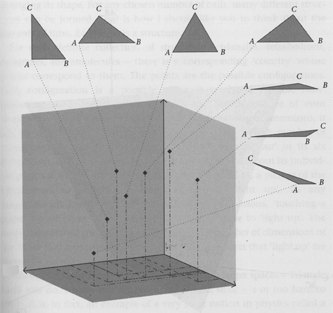
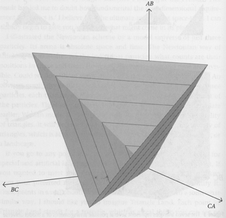
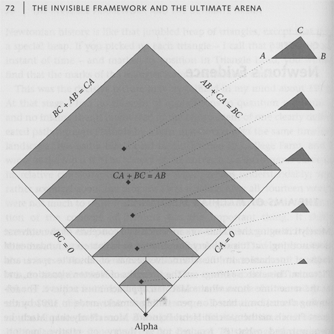
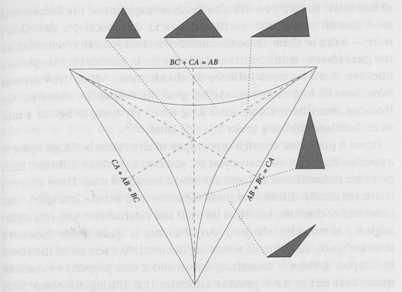
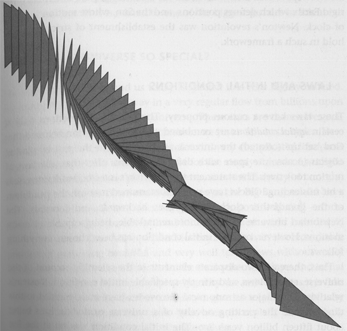
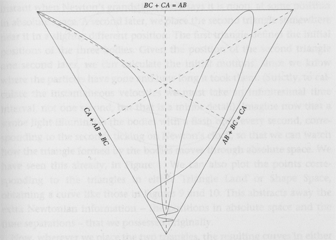
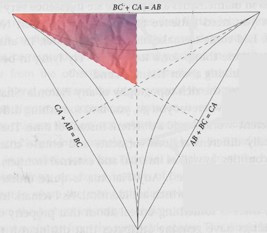
You can make positions relative in ways other than using pairwise distances as your coordinates. For instance, just take R^4n (or R^11n or whatever) and quotient by the appropriate group of isometries of R^4 or R^11 or whatever. That way you get a dimension linear in the number of particles. The space might be more complicated topologically, but if you take general relativity seriously then I think you have to be prepared to cope with that anyway.
So, in Eliezer’s example of triangles in 2-space, we start off with R^6; letting E be the group of isometries of R^2 (three-dimensional: two dimensions for translation, one for rotation, and we also have two components because we can either reflect or not), it acts on R^6 by applying each isometry uniformly to three pairs of dimensions; quotienting R^6 by this action of E, you’re left with a 2-dimensional quotient space.
Of course you end up with the same result (up to isomorphism) this way as you would by considering pairwise distances and then noticing that you’re working in a small subset of the O(N^2)-dimensional space defined by distances. But you don’t have to go via the far-too-many-dimensional space to get there.
But … suppose the laws of physics are defined over a quotient space like this. From the anti-epiphenomenal viewpoint, I wonder whether we should consider the quantities in the original un-quotiented space to be “real” or not. Consider quantum-mechanical phase or magnetic vector potential, which aren’t observable (though other things best thought of as quotients of them are). Preferring to see the quotiented things as fundamental seems to me like the same sort of error as Eliezer (I think rightly) accuses single-world-ists of.
But … the space of distance-tuples (appropriately subsetted) and the space of position-tuples (appropriately quotiented) are the same space, as I mentioned earlier. So, how to choose? Simplicity, of course. And, so far as we can currently tell, the laws of physics are simpler when expressed in terms of positions than when expressed in terms of distances. So, for me and pending the discovery of some newer better way of expressing the state space that supports our churning quantum mist, sticking with absolute positions seems better for now.
I agree that taking quotients of the configuration space is a more natural way of doing things. But, when you say
don’t you mean you’re left with a 3-dimensional quotient space? Counting degrees of freedom: wherever we put A, that eats the translation. Wherever we put B, that eats the rotation and we’re left with the distance |AB| (one dimension). Wherever we put C, that eats reflection and we’re left with the position of C up to reflection. So, the space of triangles ends up as R x R x (R / ~), where a~b iff |a|=|b|.
But then, this space should be homeomorphic to the one Eliezer gives, with the relative distances. We’ll take a point (x,y,z) in R x R x (R / ~). Then |AB|=x, |AC|=hypot(y, z), |BC|=hypot(y-x, z), clearly this is continuous and nice, and also clearly the image doesn’t change if we replace z by -z (so the function is well-defined despite the domain being a quotient space, which generally needs to be checked). Showing that the mapping is invertible, with continuous inverse, is left as exercise for the reader.
Consider now the apparent boundary when we embed this in R³; it’s z=0, which corresponds to “A, B and C form a straight line”, which (triangle inequality) corresponds to the boundary of the subset of distance-space. But if you imagine the particles moving, it’s a lot more obvious that you should bounce off the ”/ ~” surface than that you should bounce off the “if you cross this surface you get a distance-tuple that’s un-geometric” surface. Similarly, straight lines in R x R x (R / ~) correspond to fixing any two particles and moving the third in a straight line.
I would conclude from this that the equations of physics in the quotient space are likely to be much nicer than the equivalent equations in distance-tuple space.
So why bother formulating the relational configuration space in distance-tuples? After all, with the distance-tuples, you still end up having to quotient afterwards on particle-swapping to get the quantum-mechanical picture. Isn’t it easier to just use quotients, rather than an odd mix of quotients, new bases, and subsets?
(Note 1: “g” = me; I had to change my username when Less Wrong started, but existing Overcoming Bias comments kept their existing commenter names. Note 2: I only just saw this.) Yes, I meant 3-dimensional. Sorry. (And I think we are agreed that absolute space quotiented by symmetries is likely to be a nicer thing to work with than a space parameterized by relative distances.)
I’ve skimmed a few Barbour papers and I don’t see how he gets to claim space is “relational” when he has g as a fundamental element of his theory. (Here g is the metric of space but not of time; no relation to the above commenter :-) )
Roughly what proportion?
Why isn’t it? Is non-relative configuration space thought more representative of reality or just more practical to use?
I just want to know how non-standard you’re getting, I don’t expect justification yet. Thanks.
My soul as a computer programmer cries out against the idea of representing N particles with N^2 distances between them; it seems wasteful.
Even if the laws of physics are completely minimal with no absolute basis, it doesn’t mean the people running the simulation couldn’t program it in terms of absolute numbers, if that were easier. :)
Aha! Where is your Gottfried now?
But if you could learn to visualize the relative configuration space, then, so long as you thought in terms of those elements of reality, it would no longer be imaginable that Mach’s Principle could be false.
If one learned to think only in terms the relative configuration space, it would also become impossible to imagine that parity violation could be possible, since the left-hand and right-hand versions of a system have the same relative distances. Yet the weak nuclear force does violate parity.
I only discovered Julian Barbour’s work a few weeks ago, in my ongoing reading, so I’m extremely pleased to be seeing your take on his stuff.
This gives me a second perspective to check my understanding against.
@Dynamically Linked:
Interesting point, though I can’t believe Barbour et. al. wouldn’t have thought of it. My own first reaction is, “You can detect left-right reversals relative to the rest of the universe, but reversing left and right of the entire universe would give you the same internal experience.” It would also reverse the meaning of the words “left” and “right”—you have to be careful not to imagine yourself looking at the universe from outside.
@Recovering: I expect most physicists have never heard of relative configuration spaces as such. But e.g. Lee Smolin is a coauthor of Barbour’s.
Your ‘epiphenomena’ are good old invariants. When you are talking about exorcising epiphenomena, you really are talking about establishing invariants as laws that allow you to use fewer degrees of freedom. One can even talk about consciousness being only dependent on physical makeup of the universe, and hence being an invariant across universes with the same physical makeup. What is the point in reformulating it your way, exactly?
I don’t have a copy of Barbour’s book. Maybe someone who does can check what it says about parity violation? (Never mind, I just did an Amazon search inside the book, and it contains no mention of “parity” or “chirality”.)
Anyway, my understanding is that parity violation means that reversing left and right of the entire universe would not give you the same internal experience. If this is hard to imagine, suppose that the laws of physics were such that right-handed DNA works the same as in our universe, but left-handed DNA is 10% less stable. (This actually seems to be the case in our own universe, but the effect is much smaller. See http://findarticles.com/p/articles/mi_m1200/is_7_172/ai_n19492825/pg_1.) Reversing left and right of the entire universe would mean that our mutation rate suddenly increases by 10%, and the mutation rate of some aliens with left-handed DNA suddenly decreases by 10%. This kind of law of physics would be impossible to formulate with a relative configuration space.
Even if Barbour does handle this problem somehow, I think making certain types of physics impossible to imagine is not such a great idea. What if it turns out that we need those types of physics to describe our universe?
Maybe this is a stupid question… But why restrict the relative configuration space to those states that obey euclidian 3-geometry or whatever? ie, shouldn’t the physics be such that that is a consequence? The fact that “from the inside” it looks like a euclidian 3-space or whatever is more an illusion… it’s not the reality, the configuration space is the reality. So why would it “know” to obey the triangle inequality?
Besides, by relaxing that (and the various other restrictions due to the demands of the inside looking like 3-space) one could more easily represent curvature, right?
Oh, may be a stupid thought, but as far as parity: let the values go negative… with a sign flip corresponding to a parity flip, maybe? Actually, not sure about this… then two negative coordinates would have to act equivalent to no negative coordinates, I think.
I think making certain types of physics impossible to imagine is not such a great idea. What if it turns out that we need those types of physics to describe our universe?
Well, it’s not literally impossible to imagine, it’s just incoherent in that model. If it turns out that a seeming redundancy in an older model turns out not to be redundant, we can always backtrack.
I expect most physicists have never heard of relative configuration spaces as such.
huh? Don’t undergrads do abstract configuration spaces in classical mechanics? Surely all physicists have heard of symplectic reduction and Noether’s theorem?
Douglas: it’s relative configuration spaces that are being claimed as the “not widely heard of” thing, rather than configuration spaces in general.
ie, the not so widely heard of config spaces are the ones in which the dimensions correspond to distances between particles or whatever rather than any form of “absolute location”
I claim that relative configuration spaces are standard examples of abstract configuration spaces in undergraduate physics classes. I’m not sure where it falls in the curriculum, but Noether’s theorem is known to all physicists. I’m not sure exactly how they phrase that theorem, but symplectic reduction is a version that says that there’s a general procedure for producing relative configuration spaces from symmetries.
Maybe I’m overstating these generalities, but I think the claim that relative configuration spaces are unknown to most physicists is absurd.
Eliezer, this is a wonderful post, but I’d just like to correct a couple of things:
You most certainly don’t need N^2. For example, in quantum chemistry it’s common to use Z-matrices) which have precisely (3N-6) components in 3D space.
As for relativism, why not use relativistic intervals instead of distances? This way you would probably need 8N minus something (probably something=10) coordinates, and you don’t even need to arbitrarily choose axes labeled “x,y,z,t”.
In the Z-matrix, not all atoms are equivalent, but since it’s not unique, it should be possible to find a way to symmetrize it. However, for quantum physics, you probably don’t even need to care, because particles are already identical, just make sure your wavefunction has appropriate symmetry.
Finally, your cloud of complex amplitude still has an epiphenomenal factor: the absolute phase. I’m curious to see what would our usual quantum mechanics look like in a representation that would replace absolute phase with some relative coordinate :)
Each particle doesn’t exist only in one point of spacetime, but on an entire time-like curve (the worldline).
When you take into account that d(A, A) = 0 and d(A, B) = d(B, A), you only need N(N − 1)/2 distances.
You’d never even fewer in a flat 3D space, but if the particles can be in an arbitrarily curved space I think you need all of those.
N(N-1)/2 is O(N^2), which is not substantially better. Particularly to the soul of a computer scientist, which largely ignores constant factors anyway.
“My soul as a computer programmer cries out against the idea of representing N particles with N^2 distances between them; it seems wasteful”
Given 3 non-collinear points on a plane, any other point is fixed by its distances from these three points; and similar results hold in higher dimensions. You need O(N) numbers, not O(N^2) numbers to describe N particles.